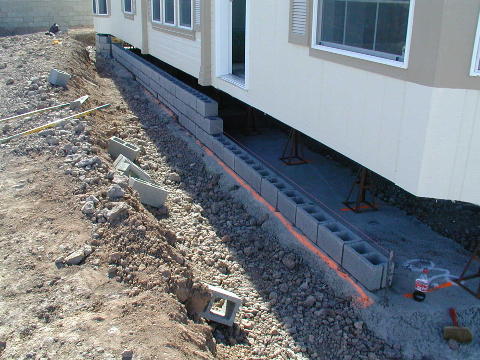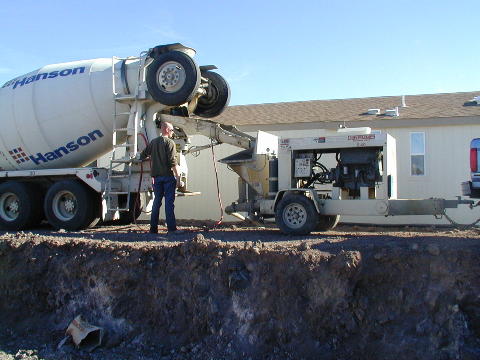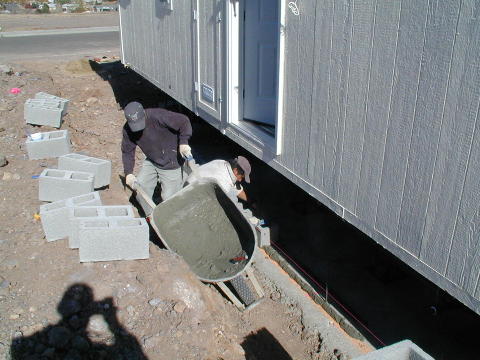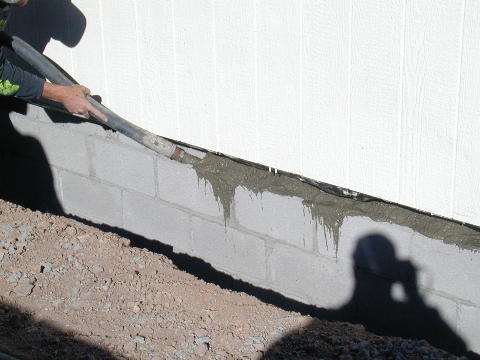Hi all,
This is an update on the progress on our house. Things happen fairly quickly when work is being done, but much of the time the crews are spread across other houses. It is sometimes frustrating, but I actually think I have been getting somewhat more than my fair share of their time.
Most of the men have been working on the two remaining houses in the old subdivision for the last week or so. One of the houses there has been completed, and the other two are within a day or two of completion. That will mean the crews can spend their time in the Northlake subdivision. There are now 5 houses there (including ours) which are all in very nearly the same state of progress.
Since the last report, the eastern half of our house was "set" and leveled. This consists of using a series of 12 ton hydraulic jacks which are on a roller base running on a piece of channel. This allows movement to the side. On the top of the jack is another roller assembly which rolls directly on the channel frame of the house, allowing movement lengthwise. This half was right on the line sideways, and within about 3 inches fore and aft. Steve used his backhoe, securely planting the bucket in the ground just in front of the hitch. Using a hydraulic jack between the backhoe and the hitch, he carefully moved the house to the exact position he wanted.
The next step was to use the 6 jacks under the house to raise it to the approximate height needed. Then jack stands were placed under each of the two large channel frame members every 5 feet along their lengths. These stands have an adjustable top which can be adjusted over about a 2 inch range using a long wrench. During this process the 10 wheels and 5 axles were removed, and snaked out from under the house and out the narrow ditch alongside. Then the hitch was unbolted and removed.
Next came the leveling. This is done in about 3 separate passes. The first pass gets it close and puts all the weight on the jack stands. The hydraulic jacks are removed. The second pass gets this half level within about 1/16 inch. The third pass will take place after both halves have been individually leveled and "married".
Before I go any farther, I should explain what a transit is and how it works (in case you don't know). It is nothing more than a high power precision telescope with crosshairs. It is accurately leveled, then everything you look at through it that appears on the crosshairs is at the same level. This allows you to check heights and levels very accurately over a fairly long distance without actually spanning the distance with a level.
The process of doing the leveling is done with the transit, which is set very low in front of the house, looking below it. A helper crawls under the house, moving from stand to stand. He holds a tape measure on the channel at each stand while Steve reads the level. Adjustments are made stand by stand until all are at equal height. As you can imagine, the 12 inch channels don't flex very much, so the leveling is an iterative process.
I asked Steve how much the houses weigh. He replied 10 to 12 tons per section. Our west section would weigh about 12 tons (24,000 pounds). That's less than our motorhome! It weighs about 25,000 pounds empty and has a gross weight of 31,000. At least when the house is together it will weigh more than the MH!
A couple of days after the first side was set, the crew descended on the west half and started the process over. This time, they got the house leveled to almost the final height using the jacks, then over a period of time, the halves were pulled together using come-a-longs at each end. They went very slowly during this process and did frequent checks both inside and out to verify proper alignment and to avoid any interferences, as well as very closely monitoring the jacks and rollers to make sure all was moving where it should. There were no problems.
When they finally got the sections together pulling the east half almost a foot sideways, and about 1 inch forward, things fit quite well - not perfectly, but quite well. The interior walls lined up perfectly at the floor, but were about half an inch off at the ceiling. By jacking on the front corner of the house, the walls lined up perfectly at the ceiling. The ceiling was not quite lined up, so a little jacking on the marriage line aligned them. Once the ceiling was lined up in both axes, they climbed on the roof and started "lagging" the halves together. This is the process of driving lag bolts from one side into the other, then from the other back. This is done every few inches the full length of the house.
After the roof was lagged, the jacks were released to their normal position where the floor and lower walls were again aligned. Now the lagging was done underneath the house along the floor marriage line. (Actually, they only finished a portion of the floor at this time.)
After the house sat for several days, the laggers returned, finished lagging the floors, and attached the interior walls where they came together at the marriage line. The roof and the end walls had expanding foam insulation squirted into the gaps on the inside and the outside. This will provide the air seal between the halves. It will be covered by trim on the outside, and by drywall inside. I found (by asking) that the front and back outside walls are not lag bolted together other than at the roof and the floor. The structure is designed that way.
The cement block crew started building the foundation wall around the perimeter of the house. In two days they completed most of the sides and the rear. They did as much as the installed footings allowed. After the front footings are poured, the final leveling process (one more round with the transit checking all stands on both halves of the home) will be done, followed by the completion of the front portion of the foundation wall.
Yesterday (Friday) we had a concrete pumper and a large ready mix truck arrive around 10:00. In about half an hour they pumped concrete into the cores of all the footing blocks in place and they finished filling the rear wall.
Monday Steve says he will back-fill the foundation walls and bring our lot down to near final height. There really is not much of the lot left to lower, as next to the house on the west is the garage which is nearly at the correct grade, then the motorhome garage which has been graded out much lower than the garage. We will be lowering a narrow strip to the east of the house, and eventually a narrow strip to the west of the motorhome garage.
Ever since the house has been placed, I have been using the french door into Betty's room to enter, as it has the narrowest gap to step over. The house is set into a trough, with the adjacent banks just about at floor level. The front door has about a 4 foot wide by about 3 foot deep chasm from the bank to the threshold. I don't even try to cross that one, but climb up from the bottom if I need to go in that door. The future garage door from the house crosses about a 3 foot gap. I can jump that, but generally don't - too hard on the knees when I land! Betty's door is over only about a 2 foot gap, and I can step over that. Once the gap is filled with dirt, I can wheel Betty across it and she can see the inside of our new house for the first time. Up till now, she has only seen about 150 photos I have taken inside.
Off and on over the last week or so, I have measured everything there is to measure in the house and transferred the measurements to a CAD drawing. I got most of it completed, but of course there were a couple of areas that just didn't fit. I re-measured several key areas and was able to get it all looking right with most of the measurements to within about 1/4 inch. (I still have a couple that miss by almost an inch!) I think that's close enough!
Till next time,
Dick
 |
| The jacks and rollers are in position, along with some "safety" stands. |
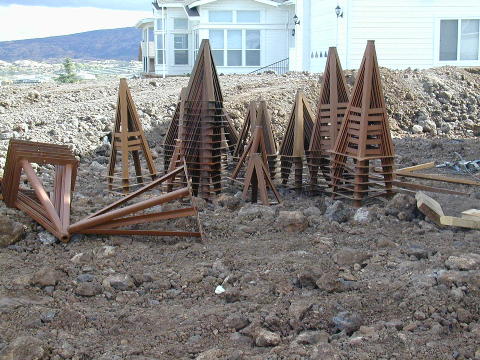 |
| They have a full range of stand heights. |
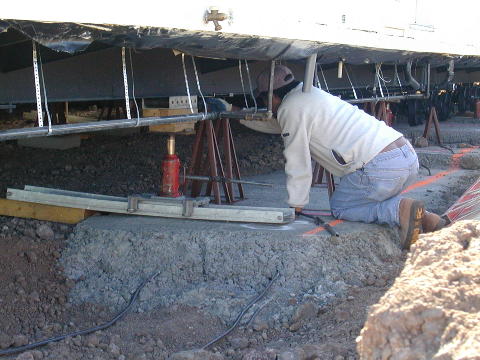 |
| Fermi is now setting the stands in their final positions. |
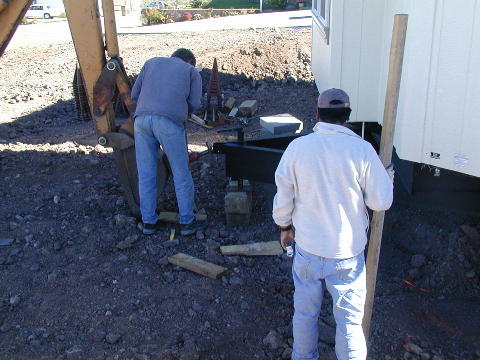 |
| Steve jacks between the backhoe and the hitch to carefully move the house back a little on the lot. |
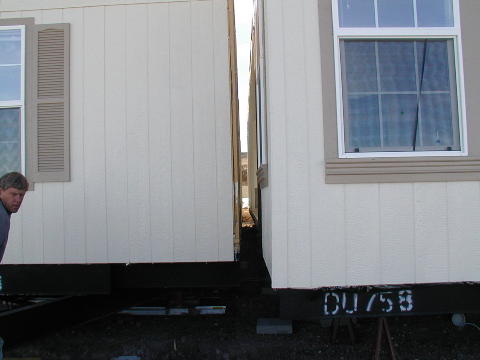 |
| Steve is carefully pulling the sections together. |
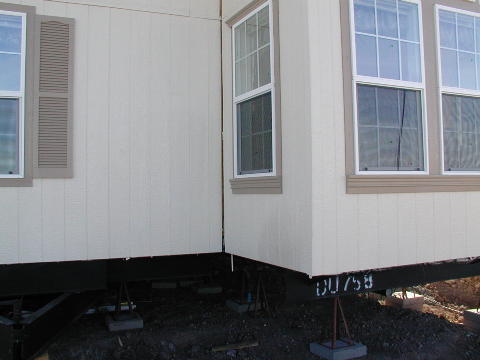 |
| It is within an inch or less now. |
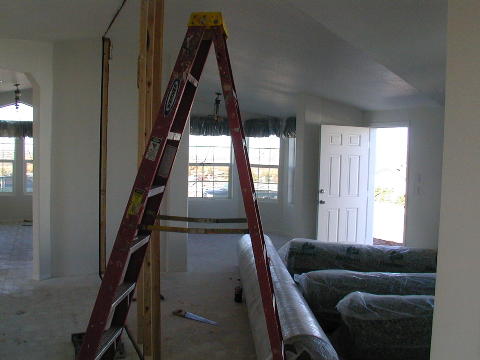 |
| The inside marriage line lines up quite well, but not perfectly yet. |
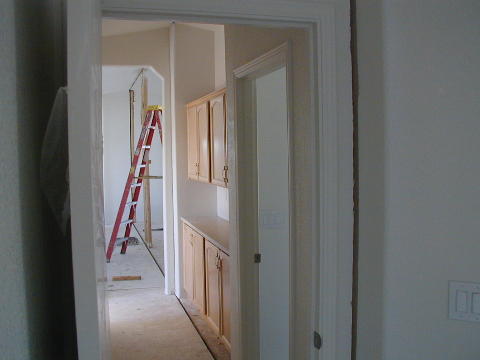 |
| Looking down the hall along the marriage line. |
